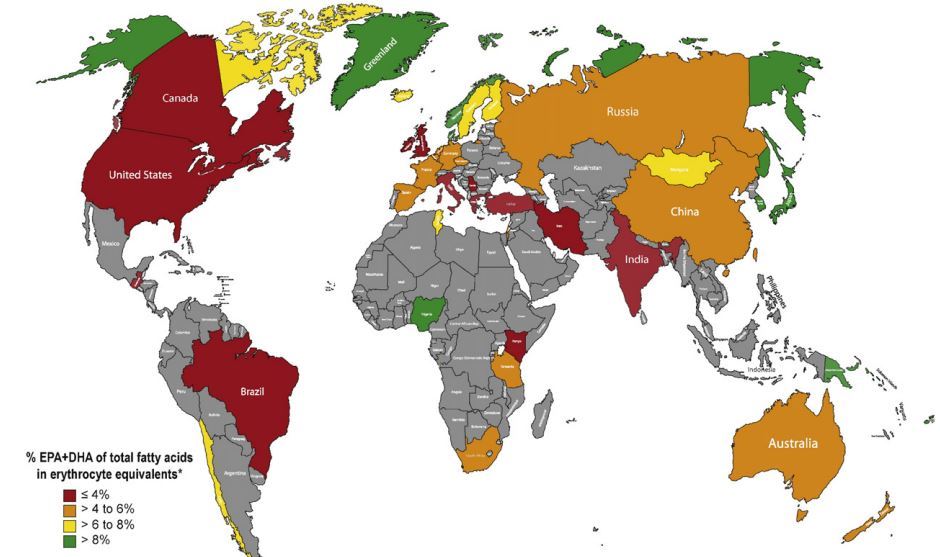Omega-3 map (most of the world has low levels)
Global survey of the omega-3 fatty acids, docosahexaenoic acid and eicosapentaenoic acid in the blood stream of healthy adults
Progress in Lipid Research, doi:10.1016/j.plipres.2016.05.001
Ken D. Stark a, kstark@uwaterloo.ca, , Mary E. Van Elswyk b, , M. Roberta Higgins c, , Charli A. Weatherford d, , Norman Salem Jr. e,
Map by DSM, and augmented by VitaminDWiki

Map in the PDF

Studies reporting blood levels of the omega-3 polyunsaturated fatty acids, eicosapentaenoic acid (EPA) and docosahexaenoic acid (DHA), were systematically identified in order to create a global map identifying countries and regions with different blood levels. Included studies were those of healthy adults, published in 1980 or later. A total of 298 studies met all inclusion criteria. Studies reported fatty acids in various blood fractions including plasma total lipids (33.0%), plasma phospholipid (32%), erythrocytes (32%) and whole blood (3.0%). Fatty acid data from each blood fraction were converted to relative weight percentages (wt.%) and then assigned to one of four discrete ranges (high, moderate, low, very low) corresponding to wt.% EPA + DHA in erythrocyte equivalents.
Regions with high EPA + DHA blood levels (> 8% ) included the
Sea of Japan,
Scandinavia, and
areas with indigenous populations or populations not fully adapted to Westernized food habits.
Very low blood levels (= 4%) were observed in
North America,
Central and South America,
Europe,
the Middle East,
Southeast Asia, and
Africa.
The present review reveals considerable variability in blood levels of EPA + DHA and the very low to low range of blood EPA + DHA for most of the world may increase global risk for chronic disease.
📄 Download the PDF from VitaminDWiki
Data from Iceland

See also VitaminDWiki
Huge increases in Omega-6 to Omega-3 ratio increase risk of obesity, etc. – March 2016
- would have been nice if the study on this page also included information of Onega-6 to Onega-3 ratios
Omega-3 levels are sub-optimal in 99 percent of Americans – Aug 2017
Football Brain injuries prevented by Omega-3 – RCT Jan 2016
- wonder if regions with high Omega-3 have fewer brain injuries
- Stillbirth rate typically 1 in 200, perhaps only 1 in 800 with Omega-3
- wonder if regions with high Omega-3 have fewer stillbirths
- Multiple Sclerosis risk reduced 46 percent by Omega-3 derived from fish (1 gram) – Sept 2015
- wonder if regions with high Omega-3 have less MS
- Schizophrenia relapses reduced 3X by Omega-3 – RCT Mar 2015
- wonder if regions with high Omega-3 have less Schizophrenia
- Cystic fibrosis problems cut in half by Omega-3 – RCT June 2015
- wonder if regions with high Omega-3 have less Cystic fibrosis
